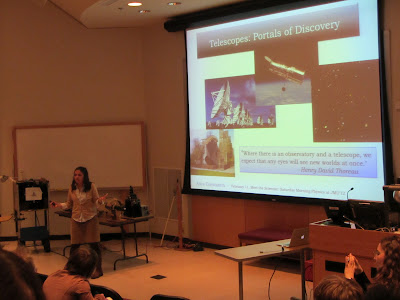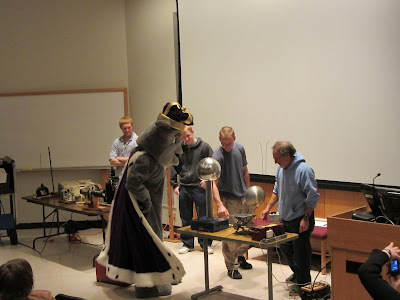Telescopes: Portals of Discovery, Prof. Anca Constantin
February 11, 2012
September 14, 2011, the news are just in: the United States Senate has decided to fully fund the James Webb Space Telescope, and it should be set to launch in 2018. This is a huge victory for astrophysics in this country. It is great to see that we are still committed to "going big, not going home." But how much do we need this telescope, and how far we've come already in building it? Why are we planning to build even greater telescopes, and which are those? Where and why did we start? We will learn in this session about the discovery voyage that led us to these questions and their answers, mainly from the passion for basic scientific discovery about the universe we live in. You'll see that the greatest telescopes we are building not only offer us spectacular images revealing dramatic episodes of star birth and death, shocking phases in evolution of new (to us) solar systems and galaxies, and thus unique insight into the universe coming into being, but also independent proof for the physical laws that govern the excitement of our daily life (or lack thereof). We will see things in light invisible to human eyes too. We will see clearer, further, and deeper. We will have the sight beyond sight. Because we build telescopes.
September 14, 2011, the news are just in: the United States Senate has decided to fully fund the James Webb Space Telescope, and it should be set to launch in 2018. This is a huge victory for astrophysics in this country. It is great to see that we are still committed to "going big, not going home." But how much do we need this telescope, and how far we've come already in building it? Why are we planning to build even greater telescopes, and which are those? Where and why did we start? We will learn in this session about the discovery voyage that led us to these questions and their answers, mainly from the passion for basic scientific discovery about the universe we live in. You'll see that the greatest telescopes we are building not only offer us spectacular images revealing dramatic episodes of star birth and death, shocking phases in evolution of new (to us) solar systems and galaxies, and thus unique insight into the universe coming into being, but also independent proof for the physical laws that govern the excitement of our daily life (or lack thereof). We will see things in light invisible to human eyes too. We will see clearer, further, and deeper. We will have the sight beyond sight. Because we build telescopes.
Group of Waynesboro High School students
Prof. Anca Constantin
"Physic is Fun" demonstrations
Duke dog came to visit Saturday Morning Physics
Other information:
1. Powerpoint of lecture
2.Quiz after the lecture
3.Podcast will be available on the Meet the Scientist: Saturday Morning Physics website
3.Photos taken by JMU






No comments:
Post a Comment